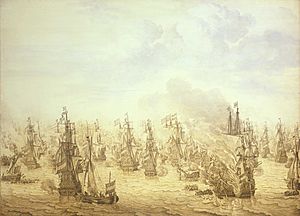HMS St George (1622) facts for kids

HMS St George at the Battle of Santa Cruz de Tenerife
|
|
Quick facts for kids History |
|
|---|---|
| Name | HMS St George |
| Ordered | February 1622 |
| Builder | William Burrell, Deptford Dockyard |
| Launched | 1622 |
| Renamed |
|
| Honours and awards |
|
| Fate | Sunk as a blockship at Sheerness, 1697 |
| General characteristics | |
| Class and type | 42-gun Great ship |
| Tons burthen | 895 (Builder's Old Measurement) |
| Length | 110 ft (34 m) (keel) |
| Beam | 37 ft (11 m) |
| Depth of hold | 16 ft 6 in (5.03 m) |
| Propulsion | Sails |
| Sail plan | Full-rigged ship |

HMS St George, sometimes called HMS George, was a powerful warship. It belonged to the English Royal Navy. This ship was built in 1622 at Deptford by Andrew Burrell.
When it was first built, St George had 42 guns. Over time, its firepower grew. By 1660, it had 56 guns. Eventually, it carried 60 guns. The ship was taken out of service in 1687. In 1697, it was sunk on purpose at Sheerness. This was done to block enemy ships from entering the harbor.
Contents
The Life of HMS St George
HMS St George was a very important ship. It served for many years in the Royal Navy. It took part in several big wars and battles.
Early Years and First Battles
The ship was launched in 1622. This means it was put into the water for the first time. Its first major action was in 1625. This was during the Attack on Cadiz. St George helped the English fleet in this attack.
A Flagship for Admiral Blake
St George became the main ship for Admiral Robert Blake. A flagship is where the admiral commands the fleet. This happened during the Anglo-Spanish War. Admiral Blake was a famous English naval commander. He was known for his bravery and skill.
Key Battles with Blake
- Battle of Santa Cruz (1657): St George was Admiral Blake's flagship in this battle. The English fleet attacked a Spanish fleet. This battle was a big victory for England.
- First Anglo-Dutch War: St George also fought in this war. This was a series of naval battles against the Dutch. Admiral Blake was on St George when he died. He was returning to England after a long journey.
Later Service and Renaming
The ship's name changed a few times. It was known as HMS George in 1650. Then, in 1660, it was renamed HMS St. George again. This was a common practice for ships back then.
More Important Battles
St George continued to fight in many more battles.
- Battle of the Gabbard (1653): A major English victory against the Dutch.
- Battle of Scheveningen (1653): Another big battle against the Dutch.
- Battle of Lowestoft (1665): A large naval battle during the Second Anglo-Dutch War.
- Four Days Battle (1666): One of the longest naval battles in history.
- Battle of Solebay (1672): A tough fight against the Dutch and French fleets.
The End of a Great Ship
After many years of service, St George was no longer used as a fighting ship. In 1687, it was "hulked." This means its masts and rigging were removed. It was then used as a floating storage or barracks.
Finally, in 1697, St George was sunk on purpose. It became a "blockship" at Sheerness. This meant it was placed to block the entrance to a harbor. This prevented enemy ships from getting in. It was a common way to protect important areas.

